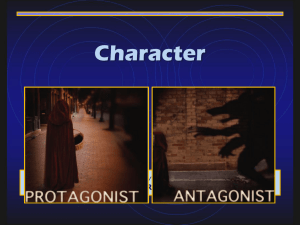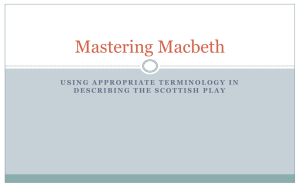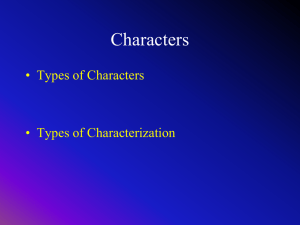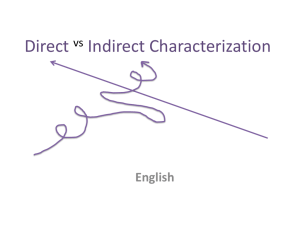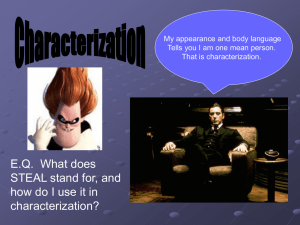Characterization "The Open Window"
advertisement
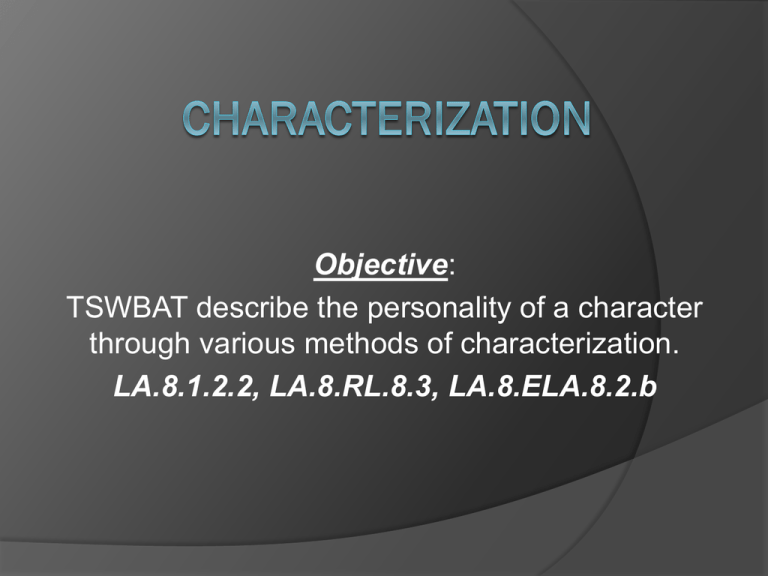
Objective: TSWBAT describe the personality of a character through various methods of characterization. LA.8.1.2.2, LA.8.RL.8.3, LA.8.ELA.8.2.b What Is Characterization? Characterization is the way a writer reveals character. Good characterization breathes life into characters and makes readers want to know more about them. Direct Characterization In direct characterization the writer simply tells us what the character is like. Margot was stylish and a bit of a snob. Margot was a daring, gregarious woman. Margot was an entertaining, but not always kind, friend. Margot was blunt to the point of rudeness. Indirect Characterization In indirect characterization, writers show a character in action and let us decide for ourselves what kind of person we are meeting. Reading indirect characterization is like getting to know a new friend. There are many clues that add up to a total picture of the person’s character. Indirect Characterization One method of indirect characterization is describing the character’s appearance. Tyler dyed his hair bright red and wore it in long, stiff ridges that stood straight up from his head. He always wore tough-looking but odd clothes, and he frowned at everyone. Indirect Characterization Another method of indirect characterization is showing the character in action. Whenever the teacher asked a question, Robert was the first to raise his hand. He would wave it back and forth until he was called on. Indirect Characterization A third method of indirect characterization is allowing readers to “hear” the character speak. When I asked Mr. Rivers to keep his dog out of our yard, he yelled, “No one tells me or my dog what to do, especially not you!” He jabbed his finger toward me. “I pay my taxes, and my dog will go wherever he likes!” Indirect Characterization A fourth method of indirect characterization is revealing the character’s thoughts and feelings. I can’t believe how frail Grandma looks, Jamal thought. She’s no bigger than a child. I never thought I would be tucking her into bed. Indirect Characterization A final method of indirect characterization is showing how others react to a character. They’d been in the river all day, and everyone was hungry, but Tina kept yelling, “Ten more miles! Ten more miles!” Ginny closed her eyes, and everyone else looked away. Finally Mike said, “You’re on your own, Tina.” “The Open Window” by Saki page 110 We will focus on TWO types of indirect characterization. Other characters’ responses Words spoken by the character Numbered Heads Together Activity (Answering Short Answer Questions: 2 pts. on LEAP) Remember the following: Turn The Question Around (TTQA) write your answer in a complete sentence use correct end punctuation and capitalization answer the question correctly. Remember the Numbered Heads Together process: T poses question. S writes answer (on his/her own). T instructs students to lean in to discuss answers. When all members are satisfied with only one answer, stop discussion and lean back. T will stop the group discussions (if they are still occurring) and select a group member to answer the question as well as explain HOW he/she found the answer. If a member does not/cannot provide the correct answer OR explanation, another group has a chance to answer and explain. Guided Practice: (page 110) At the beginning of the story Mr. Nuttel is preparing to move to a small town. He and his sister are discussing the move. QUESTION: What does Mr. Nuttel’s sister’s speech reveal about his personality? (possible answer) Guided Practice: Mr. Nuttel’s sister’s speech reveals that he is shy and does not have an outgoing personality. This is demonstrated when the text states, “You will bury yourself down there and not speak to a living soul.” Independent Practice: (page 114) QUESTION: What does the following statement from Mr. Nuttel reveal about his personality? “The doctors agree in ordering me complete rest, an absence of mental excitement, and avoidance of anything in the nature of violent physical exercise,” announced Framton…. ***EARLY FINISHERS: Select a character from a story we have read. Describe the personality of the character based on his/her action(s). (possible answer) Independent Practice: Mr. Nuttel is a very nervous, excitable man, who seems to have some type of medical condition. This is evident when he tells Mr. Sappleton that his doctors have ordered him to rest and avoid excitement and violence. Exit Ticket Question: How does the following comment made by Mrs. Sappleton help describe Mr. Nuttel as a nervous, anxious man? A most extraordinary man, a Mr. Nuttel,” said Mrs. Sappleton; “could only talk about his illnesses and dashed off without a word of goodbye or apology when you arrived.” Homework: Using Billy Weaver from “The Landlady” On Your Own (page 71), draw the chart and complete the chart found on page 135. Character Profile of ______Billy Weaver_____ Method of Characterization Appearance: Actions: Words spoken by character: Thoughts: Other characters’ responses: Writer’s direct comments: Details in Story
